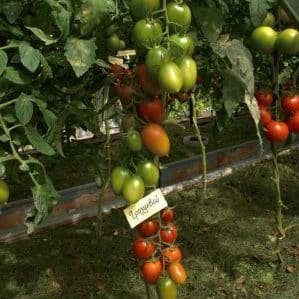Tomato "Grozdevoy" - excellent yield and memorable taste
Tomato Grozdeva is a bright representative of the group of hybrids with early ripening. It can be grown in open ground (in the southern regions) and greenhouses (in the northern regions). Juicy, tasty and healthy fruits are used to make salads and juices. Gardeners prefer to can them whole to enjoy the memory of summer in winter.
Why is the Grozdevoy F1 hybrid so popular, how to grow it and what similar analogues exist? The article will tell you everything about these tomatoes.
Description, characteristics, yield indicators

The hybrid boasts clusters of fruits that somewhat resemble bunches of grapes. Only tomatoes are much larger and heavier than berries.
The plant has many features:
- the growing season is 100–105 days;
- the bush stretches to 1.8–2.2 m in height;
- the fruits are rich red in color and look like an elongated plum with a slightly pointed tip;
- each cluster produces 8–10 tomatoes;
- weight of tomatoes – from 100 to 120 g;
- yield – 18–21 kg per bush;
- The stability of the harvest and the quality of the fruit do not change for 3-4 years.
Important! The Grozdeva F1 tomato is included in the State Register of the Russian Federation for growing under film covers on private farms.
The hybrid perfectly withstands heat and sudden temperature changes. Marketability and transportability are high. Resistant to nematode, tomato mosaic virus, verticillium and fusarium.
Advantages and disadvantages
Gardeners prefer to grow the Grozdeva hybrid because of its high yield, beauty and excellent taste of the fruit. The culture is resistant to major types of diseases and infections and is well preserved fresh.
Disadvantages of the variety:
- hybrid seeds need to be bought in a specialized store, they are not so easy to find;
- brushes are formed frequently and in large quantities, which is why tomatoes require a lot of fertilizer;
- The plant is tall, but its stems are weak and lie down under the weight of the fruit.
Attention! Bushes require support and regular garter. They also grow greatly in breadth and height. Timely formation of plants will avoid sad consequences.
How to grow
It is better to sow seeds in early March. When the spring season ends, the plant will reach 50–60 days of age and will be ready to be planted in open ground.
Summer residents from warm regions of Russia can plant seeds directly into open ground to a depth of 3-4 cm. Then they should care for the plants as if they were ordinary seedlings.
Attention! It is not recommended to select seed material for further cultivation. Otherwise, the parent plants will lose all their advantages, and the quality and quantity of the harvest will noticeably decrease.
Residents of the northern regions should grow Grozdeva tomato through seedlings. First soak the seeds in a weak solution of manganese and biogrowth stimulator “Epin” strictly according to the instructions. Then prepare the soil mixture:
- you can mix turf soil, humus and sand in a ratio of 6:3:1;
- peat, sawdust and greenhouse soil - in a ratio of 1:1:2;
- add 15–20 g of ammonium nitrate, 50–60 g of superphosphate, 15–20 g of potassium sulfate and a little ash.
The seeds are sown in a container to a depth of 1 cm, covered with polyethylene and placed in a warm place.The room should be warm - from 20 to 24 °C.
Preparing seedlings
After 2-3 true leaves appear, picking is performed. Each plant is placed in a separate container and put in a dark place, otherwise the seedlings will stretch. When the sprouts are well strengthened, the hardening procedure begins: they are moved to a cool room with a temperature of +8°C.
Soil preparation
Rotted manure, humus and sand are added to the place where the tomatoes will be planted. Add 80 g of nitroammophoska and a half-liter jar of ash. Then the bed is dug up.
Planting scheme
There should be a distance of 40–60 cm between the bushes, and 70–100 cm between the rows. When planting, it is necessary to treat the plantings with preparations that contain copper.
Attention! The area should be well lit and windless.
The best predecessors for tomatoes are cabbage, garlic, legumes, cucumbers, onions and carrots.
After planting tomatoes in the ground watered in 7 days. In the future, the soil is moistened only as it dries. Water procedures are best performed in the morning or evening.
It is necessary to feed plants with nitrogen, phosphorus, and potassium fertilizers throughout the entire growing season. The first feeding is applied after planting the seedlings in open ground, the second - during the formation of ovaries, the third - during the fruiting period.
Prevention of diseases and pests
Tomato Grozdevoy F1 is resistant to many diseases. But, as practice shows, plants can still die from adverse effects. Main diseases and pests:
- Late blight. A dangerous infectious disease that cannot always be defeated. The fruits become covered with brown rot, the root system dies, and the bush dies. The fungi move to other tomatoes and continue to parasitize.The culture is treated with Profit Gold and Abiga-Peak. Solutions are prepared in accordance with the instructions.
- Aphid And whiteflies. Insects eat leaves and feed on plant juices. They cause significant damage in a short period of time. Plantings may die even before fruiting. Tomatoes are treated with Zubr, Iskra, Zolotoy, Komandor, Apache and other fungicides.
It is important to understand that the best fight against infections and pests – this is prevention. Activities should begin in late autumn. After harvesting the last harvest, it is necessary to burn the tops of all garden crops, then dig up the soil to a depth of 25–30 cm. This way, insect larvae and fungal spores will appear on the surface, and frost will effectively do its job.
Additionally, greenhouses should be ventilated, plants should not be overwatered, and plantings should not be thickened. Massive greenery attracts various insects, prevents air and light from penetrating through tall bushes - this is where late blight and other diseases can appear.
Analogues
Tomato Grozdeva F1 has two analogues. The varieties were able to win the hearts of gardeners with their unique appearance and excellent taste. The varieties are unpretentious in care and can be proud of their high yields.
Siberian grozdevoy
Belongs to the determinant medium-sized group. Strong bushes reach a height of 90 cm and are distinguished by moderate foliage. The average weight of tomatoes is 150 g. Their shape resembles an oblong plum. The color is red-raspberry, the flesh is sweet, fleshy and sugary at the break.
The growing season is 120–130 days. One brush forms 5-6 fruits. Productivity – 7 kg per 1 sq. m in open ground and 10–12 kg per 1 sq. m in greenhouses.Siberian bunchweed is resistant to frost, has an excellent presentation and is universal in use.
Black grape
Indeterminate tall tomato. It got its name because of the dark color of the fruit. Forms 8-10 clusters, each consisting of 6-7 tomatoes. The weight of a plum tomato in bunches reaches 80 g. The yield is 12–14 kg per 1 sq. m.
The fruiting period is extended, tomatoes set until cold weather, including September, provided they are grown indoors. The bush can reach a height of 3–3.5 m, so the crown must be pinched and the plant formed into 1-2 stems. Tomatoes of the Black grape variety are very responsive to fertilizing.
It is important to apply fertilizers correctly and monitor regular watering, preventing the soil from drying out.
French grape

Gained popularity due to its high yield and low maintenance requirements. The tomato was bred by a Siberian breeder, and is produced by the Sibirsky Garden company (the same company also produces Sibirsky Grozdevoy).
It differs in that it forms a minimal number of stepsons, so the bushes do not require shaping. Resistant to late blight, dry rot and many other fungi.
Tomato has features:
- the bush reaches a height of 1–1.7 m, the stems are thick and strong;
- one brush forms 10–15 bright red tomatoes;
- one bush produces up to 10 kg of fruit (it is better to plant 3-4 plants per 1 sq. m);
- medium-sized fruits resemble a slightly elongated pear;
- one berry weighs from 70 to 100 g;
- the taste is sweet and sour, but the tomatoes are very meaty and juicy.
Attention! In the northern regions, it is better to grow French bunch tomatoes under film cover. Unfavorable conditions can significantly harm plants or even deprive them of the harvest.
Reviews from gardeners
A huge number of gardeners have already managed to enjoy the tasty and juicy tomatoes of the Grozdeva F1 hybrid, and analogues. According to them, the description fully corresponds to the result obtained.
Olesya, Ekaterinburg: «I grow Grozdevoy F1 only in a greenhouse. The fruits are smaller and more compact than in the packaging photo. Tomatoes have a regular and neat shape, rich colors and juicy pulp. The harvest can be stored for some time without losing its appearance. The only downside is that you need to buy new seeds every time, since this is a hybrid.”
Tatyana, Voronezh: “I really liked the bunch F1 because of its high yield and taste of the fruit. We use it fresh for salads; tomatoes are also good for winter preparations. When growing, you need to follow the planting scheme, otherwise neglected plants will interfere with each other with green mass.”
Ivan, Zlatoust: “The French bunch variety is very suitable for farmers. I grow it in large greenhouses for subsequent sale. Fresh tomatoes are well-sold, their attractive appearance and excellent taste are especially valued among consumers.”
Conclusion
Tomato Grozdeva F1 will become a welcome guest on any plot and table. Juicy, rich, healthy and tasty fruits will decorate your favorite dish and will delight you in winter. The main thing is not to forget to process planting material, grow seedlings correctly, and take into account the rules for planting plants in open ground and in greenhouses.
Timely feeding, formation, treatment against diseases and pests increase the immunity of tomatoes. And they, in turn, will thank you with a rich and healthy harvest.